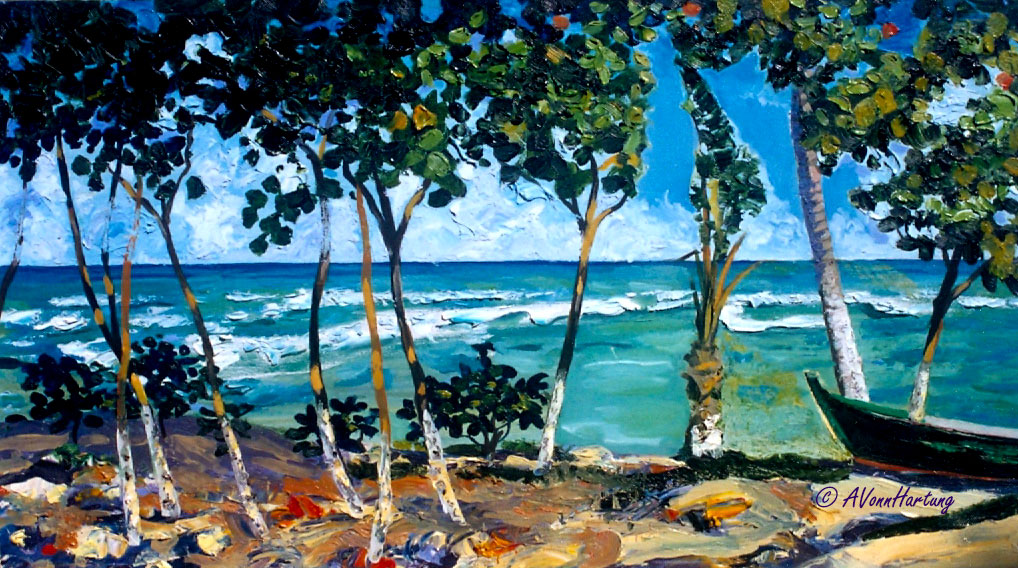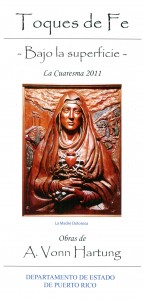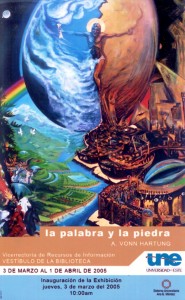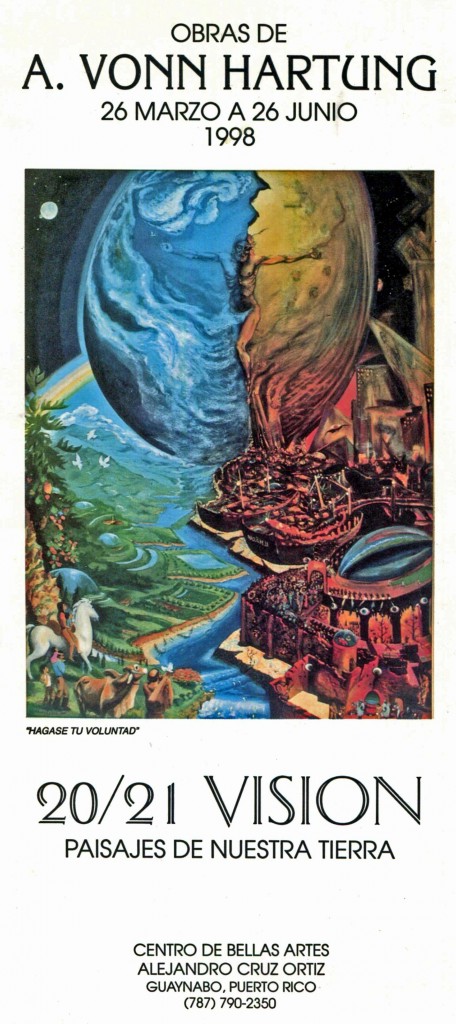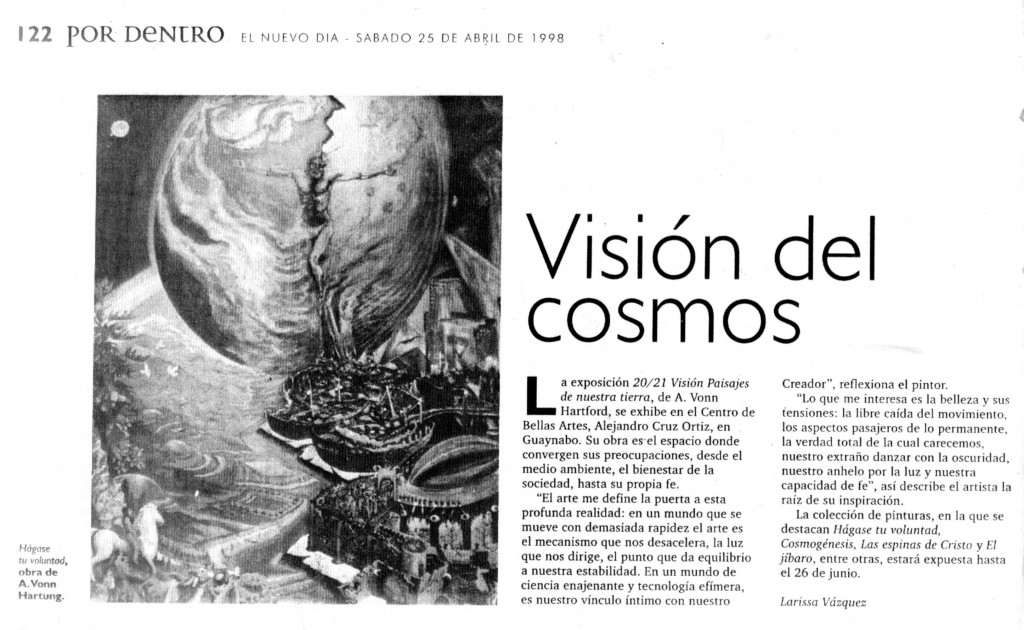Exhibit Catalog_Toques de Fe, Departamento del Estado, San Juan, Puerto Rico, Cuaresma 2011
Apertura de la Exposición Toques de Fe, presentación por Padre Jorge Santiago Cartagena SDB, Dept del Estado, San Juan 2011
ENGLISH TRANSLATION:
Padre Jorge Santiago Cartagena SDB introduces the Artist
Opening Night of Lenten Exhibit Toques de Fe
State Department, San Juan Puerto Rico, 31 March 2011
Good evening!
Today we are here admiring the works of Arthur Vonn Hartung.
Since when have I known Arturo and Patricia, his wife? Destiny made us travel together to Rome for the beatification of Carlos Manuel Rodriguez.
What better place to meet an artist than in the eternal city!There among mosaics, paintings, sculptures, old and beautiful basilicas, tombs of saints, the remainder of a dazzling empire, was born a friendship that over time has become deeper and closer.
Later, my projects as pastor in Orocovis converted the new priest friend into patron of the artist friend.
First, the great mural of the Dream of the Two Columns in the chapel dedicated to St. John Bosco and the Via Lucis painted in the manner of stained glass. Then the 3 large mosaics in the town parish, passing by other stained glass windows painted in the remodeled Sacristy and in the new chapel of the Blessed Sacrament.
All this art and creativity by Arturo made a cascade of beauty in these two churches and I appreciate it.
However, what I appreciate most about Arturo and Patricia is their friendship, their affection, their gentleness and humility.
Arturo has a life to write about in a book, he was a globetrotter and a bohemian, but above all a Christian. In him is fulfilled the parable of the pearl found in the field. When he rediscovered Jesus Christ and his Catholic faith he left everything as less to serve his true Lord and his Church with his art.
Today we are here in this beautiful room. It has become a large gallery for Arturo’s art but nothing better than Arturo and Patricia’s studio-home. There among dogs, cats, recycled materials, hanging paintings and carvings, is where Arturo gets to work his muse and affectionately receives visitors.
Thank you, Arturo for having fallen in love with our island. Today when so many flee from her you chose long ago to stay among us, you favored the colony over the metropolis, the warmth of our climate over cold New England.
I invite you to like Arturo’s art. To also become his patrons. He needs people who appreciate art and understand that in beauty that radiates is a reflection of the divine and its contemplation brings us to achieve the ineffable.
That’s my friend Arturo, with his difficult Spanish, but speaking very clearly a language that transcends borders, languages, races and political ideas, the unique language of Art.
Exhibit Catalog, La Palabra y la Piedra, Universidad del Este (UNE), Carolina, Puerto Rico, Cuaresma 2005
Apertura de la Exposición La Palabra y la Piedra, presentación por Dr. Jaime Partsch, Universidad del Este (UNE), 2005
ENGLISH TRANSLATION
Dr. Jaime Partsch introduces the Artist
Opening the Exhibit La Palabra y la Piedra
Universidad del Este, Carolina, Puerto Rico
3 March 2005
I have known Arturo Vonn Hartung for more than fifteen years. During this time I have come to admire several of Vonn’s qualities . One of his fundamental characteristics is authenticity. He says what he thinks and feels and without meaning to offend, always defends his ideas and convictions. In this sense he is a person free from any hypocrisies and deceptions. I think the works we have on display today are a reflection of a person of profound convictions.
Of course, I also admire Vonn’s artistic and creative abilities. He has obviously mastered the skills of painting, drawing, color, shape, sculpture. Everything we see here today testifies to that. But as the artist that he is, that creativity and those skills he possesses manifest an inner world that gives direction and meaning to what is created. Vonn perceives the world from the perspective of faith. The lens of spirituality allows him to interpret the world in a very particular way, with a depth and with a light that illuminates aspects of reality that are unknown by many. In a society overwhelmed by superficiality and banality, it is stimulating and hopeful to be able to count on the presence of people like Vonn and to be able to enjoy their creations. Vonn is a highly reflective, thinking person. He is a true contemplative. The works that we have here are products of Vonn’s reflections, meditations, of his contemplative life.
I cannot speak about Vonn without also speaking about his wife and companion Patty . The fact is that Patty is an extraordinary person. She possesses a patience and strength that are admirable. I know she is the hand that sustains and supports Vonn. And not only that. She is also an artist. Whether in the kitchen or in the workshop or in dealing with people, Patty brings a creativity and a vital spirit to everything she does. Truly, the works exhibited here are also her works.
There is also another element in the life of these artists that I’d like to highlight. They, Vonn and Patty, live from their art. They sustain themselves with the work of their hands, their minds and their spirit. They have built, and rebuilt their own home in Guaynabo, little by little, through the years. We all know that the life of an artist today in Puerto Rico is usually one of economic hardship and insecurity. Vonn and Patty, however, have managed to create and build amidst many difficulties a home and a workshop that are reflections of the best of the human spirit. They have lived more than twenty years in Puerto Rico. This island which they both love deeply is now their home. Puerto Rico is fortunate to be able to count on people like them.
For me it is a pleasure to introduce you to Arturo Vonn Hartung.
Bilingual Exhibit Catalog, 20/21 Visión Paisajes de Nuestra Tierra, Inauguración del Centro de Bellas Artes, Guaynabo, Puerto Rico 1998
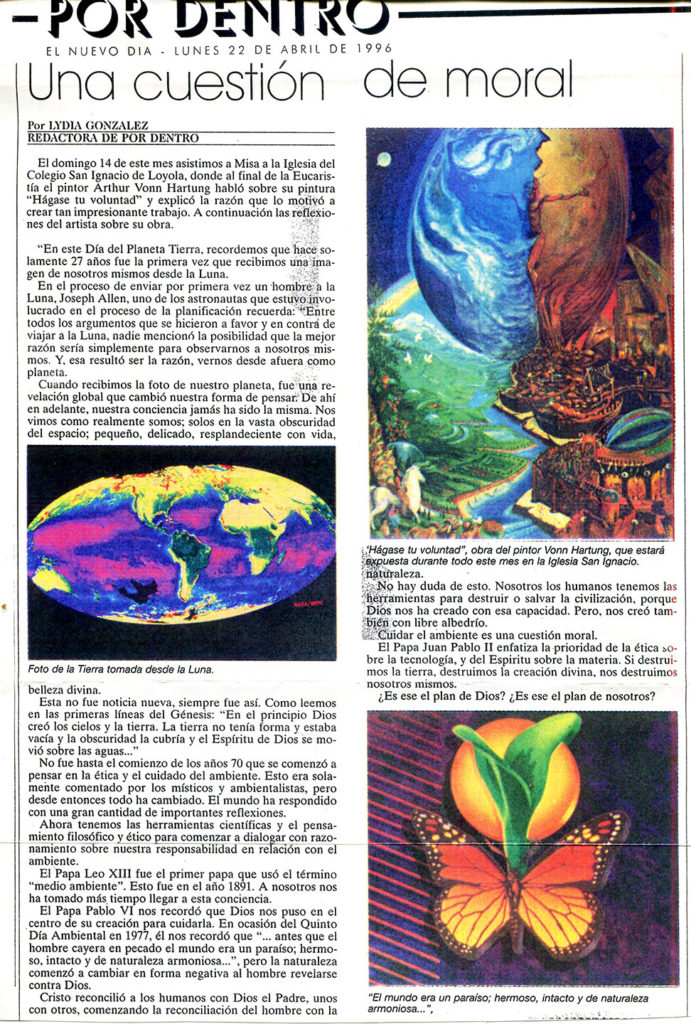 El pintor habla sobre su pintura “Hagase tu Voluntad“, en exposicion en Parroquia San Ignacio Abril 1996
El pintor habla sobre su pintura “Hagase tu Voluntad“, en exposicion en Parroquia San Ignacio Abril 1996
UnaCuestiónDeMoral_pinturaHagaseTuVoluntad
ENGLISH TRANSLATION
A Question of Morality
(Published in “El Nuevo Dia” 22 April 1996)
By Lydia Gonzalez, editor of “Por Dentro”
On Sunday the 14th of this month we attended Mass at the Church of St. Ignatius of Loyola where, at the end of the Eucharist, the painter Arthur Vonn Hartung spoke about his painting “Thy Will Be Done” and explained the reason that motivated him to create such an impressive work. Here are the artist’s reflections on his work.
“On this Earth Day, let us remember that it was only 27 years ago that we first received an image of ourselves from the Moon.
In the process of sending a man to the moon for the first time, Joseph Allen, one of the astronauts who was involved in the planning process recalls: “Among all the arguments that were made for and against traveling to the Moon , nobody mentioned the possibility that the best reason would be simply to observe ourselves.And, that turned out to be the reason, to see ourselves from outside as planet.
When we received the photo of our planet, it was a global revelation that changed the way we think. From then on, our consciousness has never been the same. We saw ourselves as we really are; alone in the vast darkness of space; small, delicate, resplendent with life, divine beauty.
This was not news, it was always so. As we read in the first lines of Genesis. “In the beginning God created the heavens and the earth The earth was without form and void and darkness covered it and the Spirit of God moved upon the waters …”
It was not until the beginning of the 70’s that we began to think about ethics and care of the environment. This was only commented on by mystics and environmentalists, but since then everything has changed. The world has responded with a lot of important reflections.
Now we have the scientific tools and the philosophical and ethical thinking to begin to reason about our responsibility regarding the environment.
Pope Leo XIII was the first pope to use the term “environment.” This was in the year 1891. It has taken us more time to reach this awareness.
Pope Paul VI reminded us that God put us in the center of his creation to take care of it. On the occasion of the Fifth Environmental Day in 1977, he reminded us that “before man fell into sin the world was a paradise, beautiful, intact and of a harmonious nature …”, but nature began to change in a negative way when man rebelled against God.
Christ reconciled humans with God the Father, with one another, beginning the reconciliation of man with nature.
There is no doubt about this. We humans have the tools to destroy or save civilization, because God created us with that capability. But he also created us with free will.
Caring for the environment is a moral issue.
Pope John Paul II emphasizes the priority of ethics over technology, and spirit over matter. If we destroy the earth, we destroy the divine creation, we destroy ourselves.
Is that God’s plan? Is that our plan?
